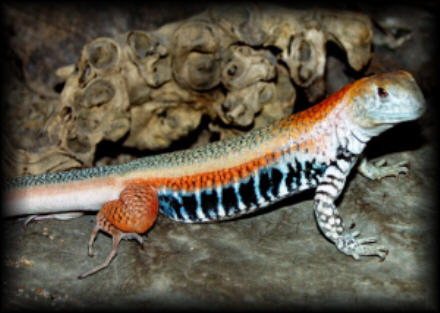Agama - Butterfly
Butterfly Runner, Butterfly Lizard Scientific Name: Leiolepis belliana
Mon, 28th April, 2025 - 9:40 am GMT
Sponsor Ads:

Alternative Name
Butterfly Runner, Butterfly Lizard Scientific Name: Leiolepis bellianaBasic Info
The Butterfly Agama can reach 20 inches, or 50 centimeters in length. They have a slightly flattened body and a rounded head. Their tail is long and characterized by slightly keeled scales. The scales on the body are very small and resemble grains of sand. They lack a crest and gular pouch, although they do exhibit a wide gular fold. Femoral pores are present on the males. The back of the Butterfly Agama is gray or olive green, and the sides are yellow or red with black stripes.
Health
The Butterfly Agama should be kept in an arid enclosure with deep substrate so they can dig. The temperature should be between about 85 degrees Fahrenheit (30 degrees Celsius) during the day with a basking area about 95 degrees Fahrenheit (35 degrees Celsius). The temperature should be lowered at night by about 10 (Fahrenheit) degrees.They should always have access to plenty of fresh water. Breeding These lizards are reported to be strictly monogamous. They are oviparous, meaning they lay eggs rather than giving birth to live young.Habitat
Butterfly Agama prefers to live in arid, open regions.Behavior
The Butterfly Agama has recently become more popular as a pet, however, not much is known about their behavior in their natural environment. Native to Vietnam and other areas in Asia, the Butterfly Agama prefers to live in arid, open regions. They are terrestrial lizards, meaning that they live on the ground rather than in the trees. They often make their homes in deep burrows, which they dig themselves. In captivity they do well on a diet of insects, including crickets. Some fruits and vegetables may also be given as a treat. Some individuals may eat more of these than others. Their main diet, hwoever, should consist of insects.Origin
AsiaHistory
The Butterfly Agama is one of many lizards of which very little is known. They are native to Thailand, Burma, Laos, Cambodia, Indonesia and Vietnam.Common Foods
The Butterfly Agama is an insectivore, although they will eat plants if necessary. It has been reported that the Butterfly Agama is monogamous.Sponsor Ads:
In the fight between you and the world, back the world. --Frank Zappa
Agama - Butterfly
Coded by: BGID® | ALL RIGHTS RESERVED Copyright © 2000-2025
Disclaimer | Privacy | Report Errors / Contact | Credits


 Why haven't we as a collective earth met with aliens yet?
Why haven't we as a collective earth met with aliens yet?  The Best Text Adventure You Will Ever Play! The official site:
The Best Text Adventure You Will Ever Play! The official site:  Homosexual behavior stems from the mind or genetics?
Homosexual behavior stems from the mind or genetics?  World EcoSystem - Biodiversity Changes - Who is on board and who isn
World EcoSystem - Biodiversity Changes - Who is on board and who isn  Mouthwash - Mouthrinse - Mouth Sores - Healing Infections - Gingivitis
Mouthwash - Mouthrinse - Mouth Sores - Healing Infections - Gingivitis  Treatment for Depression
Treatment for Depression  Ultra radical and violent Islamist group that even rivals Al Qaeda
Ultra radical and violent Islamist group that even rivals Al Qaeda  An idea to have teachers who want to carry guns to school undergo some level of police training will be left up to local school districts and police departments.
An idea to have teachers who want to carry guns to school undergo some level of police training will be left up to local school districts and police departments.